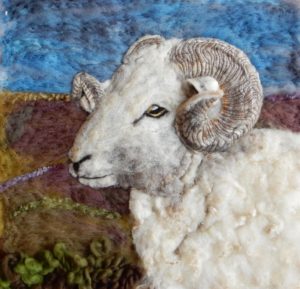by
Charlotte Moreton
13th October 2020
I wander along the dry valley of Tinkley Bottom, glancing at the sheep-sprigged slopes and making a quavery job of Handel’s O Lovely Peace, “Let fleecy flo-ocks the hi-ills ado-or-orn…”, morphing into “Tis the season to be woolly…” as I puff up the slope between low-lit ranks of ancient ant hills.

It is no coincidence that Wool Week falls at the time of year when we pull out our favourite knitwear, inspecting for casualties to moth and being alert for unmissable new delights from merino thermals to traditional and contemporary landscape-inspired patterns. Social media is bright with #woolweek posts, this year October 5th-18th, celebrating the animals that close-crop our grassy landscapes and have clothed us for millennia. While most of the big commercial flocks are mixed-breed, there are many local and rare breeds: Dorset Horn (can breed year-round), Poll Dorset (easier to handle with no horns), Dorset Down, Hampshire Down, Wiltshire Horn, all developed for particular characteristics – breeding times, fleece and meat quality. We see the Herdwick too, with its dark wool and white face, often chosen for conservation sites where their hardiness and ability to survive purely on forage outweighs the lower lambing capacity and coarser, weather-proof wool.
I enjoy the thought that the drove roads, the Ancient Ways (today woven into an extensive and developing network of footpaths and bridleways) across the velvety downland and wooded landscapes of Cranborne Chase have been the supply route, the arterial flow for the wool trade allowing the surrounding towns and the city of Salisbury to prosper. In mediaeval times and up until the 17th Century the wool trade provided much of the wealth of the country, shown here in a neat timeline, beginning with the upright looms used in the Iron Age.

Watch for Iron Age textile demonstrations as part of our Living History project with Chalke Valley History Festival next June, postponed for too-familiar reasons from its intended date this year.
Salisbury is long-famed for the quality of its fine woollen cloth, and its striped cloth or rays, examples of which can be seen at Salisbury Museum. The famous Salisbury Giant was created in Mediaeval times to show off the skills of the Tailors Guild, and it (or its successor) still comes out for parades and carnivals. We can admire him too at Salisbury Museum.
Along the drove roads (yes, Ox Drove being one) we have pubs named for the wool trade – The Ship (from shep) at Burcombe, and further south west the Ship in Wool (this name actually comes from “well”), by Wareham. The lamb at Hindon; or was this a holy lamb…? And we have plenty of linked surnames, from Shepherd and Webster to Fuller and Tucker compiled here in an edifying blog. Look out for place names, too, with Shep-, Ship-, Sher-….
The likes of Ted Hughes and John Clare tickle us with sheepish words (and sometimes the wool is pulled over our eyes). We would love to hear yours, if you felt (there’s one!) like shearing (oops – another!). Our Words in the Landscape project will knit up the baa-dest and woolliest of your compositions to be published online as we wind on down the drove road, weaving words into song and verse, prose and worse….
